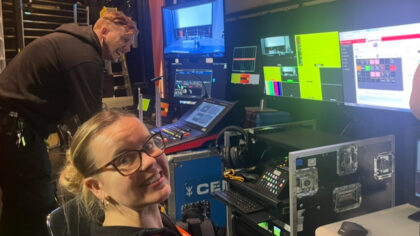Home / Latest news /
– a guide from Centas
Hybrid meetings and events, which combine physical participation with remote digital guests, have become the new standard in the event industry. Organizing a successful hybrid event or hybrid meeting requires careful planning and thoughtful strategy to ensure that both physical and digital participants have a positive and engaging experience.
Centas has been a technology partner to countless hybrid meetings and events, from small gatherings to huge conferences. Here we share insights and tips for creating successful hybrid meetings.
Why organize hybrid meetings?
This might be a good question to ask yourself to start with. Why should you organize meetings and events where digital participation is possible? And is it something for your particular event?
As we all know, it started during the pandemic, when our way of looking at meetings, events and conferences changed radically. Back then, the digital version was the only way to organize an event. When physical events became possible again, digital was left behind, people started to expect to be able to choose how they wanted to participate, no matter where they were. The hybrid meeting was born.
 Benefits of hybrid meetings
Benefits of hybrid meetings
The benefits of hybrid meetings and events are numerous. The most prominent ones are:
Increased reach – you reach more people and don’t have to have a maximum number of participants based on the capacity of the venue.
Cost-effective – reduced costs for both organizers and participants. Smaller venues and reduced logistical arrangements for the organizer, and no travel and accommodation costs for the participant.
Flexible – when participants can decide how to participate, more people will participate.
Higher level of interaction – better opportunities for sponsors and partners to interact with participants in different ways.
10 tips for successful hybrid meetings
To succeed with hybrid meetings and events, it is crucial to think two-dimensionally – one part focusing on the physical participants and another part targeting the digital participants. Here are our top tips in key areas.
Technical infrastructure
1 Ensure that you have a robust and reliable technical platform to manage both physical and digital participants.
2 Invest in high-quality sound, light and video equipment to create a professional experience for all participants. It can be done cheaply or well, unfortunately not both. However, by renting the technology from us, you don’t have to buy and store all the equipment yourself.
Interactivity
3 Create opportunities for both physical and digital participants to interact and ask questions.
4 Use tools such as mentometer and chat rooms to engage the digital audience.
Tailor-made experiences
5 Customize invitations and experiences depending on the role of the participant (VIP, sponsor, paying participant, etc.).
6 Offer different pricing and tickets to meet different needs and preferences.
Engaging content
7 Develop content that is relevant and appealing to both physical and digital participants.
8 Plan for parallel activities so that there is always something to participate in, whether in person or online.
Moderators and speakers
9 Use experienced moderators who can handle both physical and digital interactions.
10 Train speakers to engage a digital audience, where they do not receive direct feedback in the same way as at physical events.
Avoid the pitfalls of hybrid meetings
Organizing hybrid events comes with challenges. Here are some pitfalls to avoid:
- Don’t underestimate the importance of good technology – poor technical infrastructure can ruin the experience for digital participants. Make sure that all technical aspects are well tested and functional.
- Don’t forget about some of the participants – make sure that both physical and digital participants get equal attention and opportunities to participate.
- Don’t make it difficult to register – a simple and user-friendly registration page is key to attracting participants. Avoid unnecessary steps and make the process as smooth as possible.
- Don’t have too long sessions and too many speakers – break the program into shorter and more manageable segments to keep participants’ attention.
Final tips for successful hybrid meetings
Plan well in advance
Start planning early and contact a production company to help create a tailor-made solution.
Invest in technology
Put the most effort into delivering high quality broadcasting for the digital and the on-site experience for the physical participants.
Creating a shared community
Build a sense of belonging and engagement among participants, whether they are on-site or online.
Hybrid meetings and events are the future of the events industry and with the right strategy and planning, you can create memorable and successful events that meet the needs and preferences of all participants.
Contact Centas for help with hybrid meetings.


